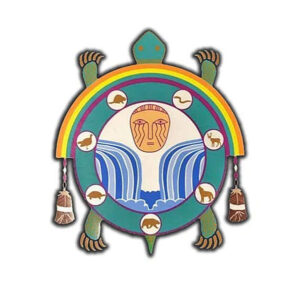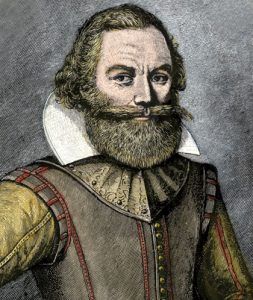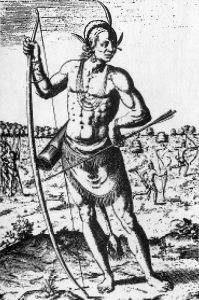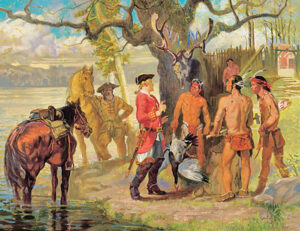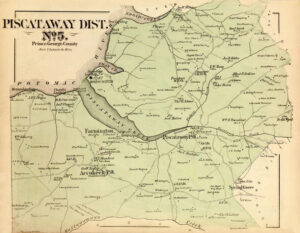The Piscataway/Conoy people are an Algonquian tribe related to the Lenape/Delaware, from whose ancestral stem they sprang. However, their closest relations were with the Nanticoke, with whom they probably were united in late prehistoric times, the two forming a single tribe. Their language is supposed to have been somewhat closely allied to that spoken in Virginia by the Powhatan. Piscataway means “the people where the river bends.” Their lands spread from present day southern Maryland, including Baltimore, Montgomery, Anne Arundel Counties, and the Washington, D.C., areas.
They were a sedentary hunter-farmer tribe that lived between the Potomac River and the western shore of the Chesapeake Bay in Maryland. They lived in permanent villages near waters navigable by canoes. The women planted various crops, including maize, several varieties of beans, melons, pumpkins, squash, and ceremonial tobacco, and gathered berries, nuts, and tubers to supplement their diets. They also made pottery, woven baskets, and beaded jewelry. Men used bows and arrows to hunt bears, elk, deer, wolves, and smaller game such as beaver, squirrels, partridges, and wild turkeys. The men made dugout canoes, fished, and harvested oysters and crabs.
As with other tribes, smaller Piscataway bands — including the Chaptico, Moyaone, Nanjemoy, and Potapoco, allied themselves for purposes of defense and trade. They appointed leaders to the various villages and settlements.
As was common among the Algonquian peoples, Piscataway villages comprised several individual houses protected by a defensive log palisade. Traditional houses were rectangular and typically 10 feet high and 20 feet long, a type of longhouse, with barrel-shaped roofs covered with bark or woven mats. A hearth occupied the center of the house with a smoke hole overhead.
Europeans first made contact with the Piscataway tribes in 1608 through encounters with Captain John Smith and William Claiborne. At that time, the Piscataway were the largest and most powerful tribal nation in the lands between the Chesapeake Bay and Potomac River. Their traditional territory primarily included present-day Charles, Prince George’s, and St. Mary’s Counties, extending north into Baltimore County and west to the foothills of the Appalachians.
In 1634, many European colonialists began to settle in earnest when the ships the Ark and the Dove arrived in Maryland carrying Leonard Calvert and Jesuit priest Andrew White. The tribe was friendly to the early settlers and helped them to adjust to the new lands.
Jesuit missionary Father Andrew White translated the Catholic catechism into Piscataway in 1640, and other English missionaries compiled Piscataway-language materials.
By 1660, colonialists began to encroach on indigenous lands and expand into their territory, which changed the dynamic of the early relationships and caused conflicts to emerge.
In 1666, Lord Baltimore signed the first of a series of treaties to acquire lands from the Piscataway. These treaties were always broken. When the Piscataway were finally pushed off their lands, the Confederacy members gave them the title of Piscataway Conoy. They briefly settled in various areas, but because of intertribal fighting and European encroachment, some kept traveling all the way to Canada.
In 1670, the tribe was devasted by a smallpox epidemic. Most confederated with other tribes as a result of white settlement. Some branches of the Piscataway tribe may have become extinct due to intertribal fighting and infections from European diseases.
Colonial authorities forced the Piscataway to permit the Susquehannock, an Iroquoian-speaking people, to settle in their territory after the Iroquois Confederacy, based in New York, defeated them in 1675. The traditional enemies eventually came to open conflict in present-day Maryland. With the tribes at war, the Maryland Colony expelled the Susquehannock after the Piscataway attacked them, and the Susquehannock suffered a devastating defeat.
Piscataway fortunes declined as the English Maryland colony grew and prospered. In 1680, after the English tried to remove tribes from their homelands, the Piscataway fled from encroaching English settlers to Zekiah Swamp in Charles County, Maryland. There, they were attacked by the Iroquois, but peace was negotiated.
In 1697, the Piscataway relocated across the Potomac River and camped near The Plains, Virginia, in Fauquier County. Virginia settlers were alarmed and tried to persuade the Piscataway to return to Maryland, though they refused. Finally, in 1699, the Piscataway moved north to what is now called Heater’s Island in the Potomac River near Point of Rocks, Maryland. They remained there until after 1722.
The American Revolution took a toll on many tribes as they allied with one side or the other. By the end of the war, their villages were devastated. The Piscataway-Conoy were not spared this tragedy, and their remaining numbers were scattered. Some traveled northwest to what is now Detroit, Michigan, and parts of Canada, where they were absorbed into local tribes.
Colonial governments granted the Piscataway reservations called manors, but by 1800, even those rights were retracted.
Their alliance began to crumble as the various bands splintered and sought new lands. The largest contingent of the tribe, known as the Conoy, migrated to Pennsylvania and settled for a time by the Susquehanna River with their former enemies — the Haudenosaunee — and sought the protection of German Christians.
Through it all, a small number of the tribe remained in Southern Maryland, scattered among the towns and villages, no longer a unified people. Over the years, they gradually melted into the local fabric, living quiet, rural lives. By then, the Piscataway had lost more than their tribe; they lost their identity as a people.
In the 1970s, on the heels of the Civil Rights Era, the Pan-Indian movement inspired Native American groups all over the nation to reclaim their rights and identities and to fight for recognition in a society that had marginalized them for hundreds of years.
Some Piscataway descendants, who were often belittled and discriminated against within their communities in Southern Maryland, saw an opportunity to recover their traditional way of life. Several individuals and groups, initially working independently of each other, started the long process of tribal recognition by the state.
Because so much of their history was lost over time, the Piscataway Nation spent years reassembling the culture from written records and oral tradition. Although the government did not keep records on the Piscataway people, the Catholic Church, to which they were adherents, held many family records and other information, which helped identify more than 5,000 Marylanders as hereditary members of the tribe.
For decades, the Piscataway worked with the state — specifically the Maryland Commission on Indian Affairs — for official recognition of their tribe. Cultural acknowledgment, acceptance, and access to federal funds for education, housing, public health, and other programs were at stake. Finally, in January 2012, at a ceremony in Annapolis, Maryland, representatives and leaders were officially recognized by executive order, confirming what they had always known: that they are a distinct people with a long cultural history in Maryland that goes back centuries.
Their descendants today number about 200 and belong to the Maryland Indian Heritage Society, Piscataway Conoy Confederacy, and the Piscataway Indian Nation. Others live with Ontario’s Six Nations of the Grand River First Nation; some, who fled south, merged with various tribes in North Carolina.
More Information:
Piscataway-Conoy Tribe
P.O. Box 638
Bryans Road, Maryland 20616
©Kathy Alexander/Legends of America, updated March 2024.
Also See:
List of Notable Native Americans
Native American Heroes and Legends
Native American Photo Galleries
Sources:
Greenbelt News Review
Maryland Department of Natural Resources
Piscataway Indians
Wikipedia

